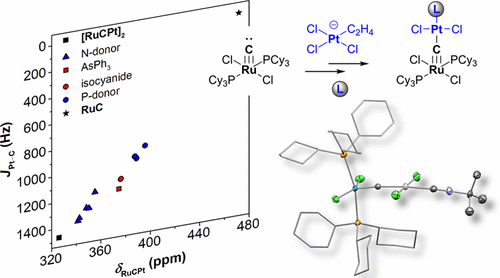当前位置:
X-MOL 学术
›
Inorg. Chem.
›
论文详情
Our official English website, www.x-mol.net, welcomes your
feedback! (Note: you will need to create a separate account there.)
Weakening of Carbide–Platinum Bonds as a Probe for Ligand Donor Strengths
Inorganic Chemistry ( IF 4.3 ) Pub Date : 2017-09-25 00:00:00 , DOI: 10.1021/acs.inorgchem.7b01956 Anders Reinholdt 1 , Jesper Bendix 1
Inorganic Chemistry ( IF 4.3 ) Pub Date : 2017-09-25 00:00:00 , DOI: 10.1021/acs.inorgchem.7b01956 Anders Reinholdt 1 , Jesper Bendix 1
Affiliation

|
We report the observation of the weakening of the RuC–Pt single bond in (Cy3P)2Cl2Ru≡C–PtCl2–L (Ru≡C–Pt–L) complexes, leading to the incipient formation of the terminal ruthenium carbide complex, (Cy3P)2Cl2Ru≡C (RuC). In the solid state, elongation of RuC–Pt bonds illustrates the degree of weakening, and in solution, decreasing platinum–carbide coupling constants and increasing carbide chemical shifts reveal weaker interaction through the carbide bridge, as the electron donating ability of L becomes progressively stronger. For the bridging carbide ligands, the chemical shifts and coupling constants to platinum are linearly dependent, and NMR data for parent RuC conform to this relationship, providing a spectroscopic means of determining the strength of the RuC–Pt linkages relative to dissociated RuC. The pliancy of the Ru≡C–Pt–L fragment with regard to the identity of L establishes the carbide-bridged complexes as remarkably wide-ranging and sensitive probes for ligand donor abilities.
中文翻译:

碳化物-铂键的弱化作为配体施主强度的探针
我们报告了在(Cy 3 P)2 Cl 2 Ru≡C–PtCl 2 –L(Ru≡C–Pt–L)复合物中RuC–Pt单键减弱的观察,导致末端的初期形成钌复合碳化物,(CY 3 P)2氯2孺≡ C(RUC)。在固态中,RuC–Pt键的伸长说明其弱化程度,而在溶液中,随着L的给电子能力逐渐增强,降低的铂-碳化物偶联常数和增加的碳化物化学位移显示出通过碳化物桥的相互作用较弱。 。对于桥接的碳化物配体,铂的化学位移和偶联常数是线性相关的,并且母体RuC的NMR数据符合此关系,从而提供了一种确定相对于解离的RuC的RuC-Pt键强度的光谱方法。Ru≡C–Pt–L的柔韧性 关于L的同一性的片段确定碳化物桥接的复合物是配体供体能力的非常广泛且灵敏的探针。
更新日期:2017-09-25
中文翻译:

碳化物-铂键的弱化作为配体施主强度的探针
我们报告了在(Cy 3 P)2 Cl 2 Ru≡C–PtCl 2 –L(Ru≡C–Pt–L)复合物中RuC–Pt单键减弱的观察,导致末端的初期形成钌复合碳化物,(CY 3 P)2氯2孺≡ C(RUC)。在固态中,RuC–Pt键的伸长说明其弱化程度,而在溶液中,随着L的给电子能力逐渐增强,降低的铂-碳化物偶联常数和增加的碳化物化学位移显示出通过碳化物桥的相互作用较弱。 。对于桥接的碳化物配体,铂的化学位移和偶联常数是线性相关的,并且母体RuC的NMR数据符合此关系,从而提供了一种确定相对于解离的RuC的RuC-Pt键强度的光谱方法。Ru≡C–Pt–L的柔韧性 关于L的同一性的片段确定碳化物桥接的复合物是配体供体能力的非常广泛且灵敏的探针。











































 京公网安备 11010802027423号
京公网安备 11010802027423号